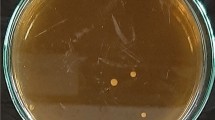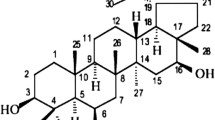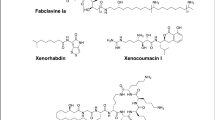Abstract
Purpose
The current study was designed to evaluate the toxicity of the secondary metabolites of Lactobacillus plantarum against the human breast cancer cell line (MCF-7) and the Drosophila melanogaster.
Methods
In this study, toxicity analyses of secondary metabolites of Lactobacillus plantarum were analyzed on breast cancer cells, and the Drosophila melanogaster. After application, in the MCF-7 cell line, expression levels of RRAS-2, TP53, BCL-2, APAF-1, CASP-3, FADD, CASP-7, BOK genes; in D. melanogaster; expression levels of RAS64B P53, BUFFY, DARK, DECAY, FADD, DRICE, and DEBCL genes were determined by RT-PCR. In addition, analysis of L. plantarum secondary metabolite was performed by GC–MS method and molecular binding poses of secondary metabolites and human enzymes were investigated in silico.
Results
Drosophila melanogaster being used as a model organism where some of the human genes were preserved. The IC50 value of the secondary metabolite in the MCF-7 cell line was determined to be 0.0011 mg/ml. Lethal concentration 50 (LC50) and 99 (LC99) values of secondary metabolites against fruit fly adults were 0.24 mg/ml and 0.54 mg/ml, respectively. The expression levels of BCL-2 and BUFFY genes which are anti-apoptotic in human and fruit flies have been reduced, and at the same time, increased expression of DECAY, FADD, RAS64B apoptotic genes in D. melanogaster.
Conclusion
The substance detected in the secondary metabolite content and encoded as L13 (3-phenyl-1, 2, 4-benzotriazine) has been observed to have high binding affinity in the studied genes.







Similar content being viewed by others
References
Oh S, Kim SH, Worobo RW (2000) Characterization and purification of a bacteriocin produced by a potential probiotic culture, Lactobacillus acidophilus 30SC. J Dairy Sci 83:2747–2752
Kleerebezem M, Boekhorst J, van Kranenburg R, Molenaar D, Kuipers OP, Leer R, Tarchini R, Peters SA, Sandbrink HM, Fiers MW, Stiekema W, Lankhorst RM, Bron PA, Hoffer SM, Groot MN, Kerkhoven R, de Vries M, Ursing B, de Vos WM, Siezen RJ (2003) Complete genome sequence of Lactobacillus plantarum WCFS1. Proc Natl Acad Sci 100:1990–1995
WHO (2018) World Health Organization. http://www.who.int. Accessed 05 June 2018
Tan ML, Choong PFM, Dass CR (2009) Cancer, chitosan nanoparticles and catalytic nucleic acids. J Pharm Pharmacol 61:3–12
Baguley BC (2010) Multiple drug resistance mechanisms in cancer. Mol Biotechnol 46:308–316
Sharom FJ (2011) The P-glycoprotein multidrug transporter. Essays Biochem 50:161–178
Parton M, Dowsett M, Smith I, Smith I (2001) Studies of apoptosis in breast cancer. BMJ 322:1528–1532
Wolf MJ, Amrein H, Izatt JA, Choma MA, Reedy MC, Rockman HA (2006) From the cover: Drosophila as a model for the identification of genes causing adult human heart disease. Proc Natl Acad Sci 103:1394–1399
Trott O, Olson AJ (2010) AutoDock Vina: improving the speed and accuracy of docking with a new scoring function, efficient optimization and multithreading. J Comput Chem 31:455–461
Mohapatra AK, Pandey P (2018) Fecundity of inbred fruit fly Drosophila melanogaster on different solid culture media: an analysis. J Appl Nat Sci 10:1109–1114
Humphrey W, Dalke A, Schulten K (1996) VMD-visual molecular dynamics. J Mol Graph 14:33–38
Schrödinger Release 2019-1: Maestro, Schrödinger, LLC, New York, NY (Free Academic)
Abbott WS (1925) A method of computing the effectiveness of an insecticide. J Econ Entomol 18:265–267
Chuah LO, Foo HL, Loh TC, Alitheen NBM, Yeap SK, Abdulmutalip NE, Abdulrahim R, Yusoff K (2019) Postbiotic metabolites produced by Lactobacillus plantarum strains exert selective cytotoxicity effects on cancer cells. BMC Complem Altern Med 19:114
Kotovskaya SK, Zhumabaeva GA, Perova NM, Baskakova ZM, Charushin VN, Chupakhin ON, Belanov EF, Bormotov NI, Balakhnin SM, Serova OA (2007) Synthesıs and antiviral activity of fluorinated 3-phenyl-1,2,4-benzotriazınes. Pharm Chem J 41(2):62–68
Simon MA, Bowtell DDL, Dodson GS, Laverty TR, Rubin GM (1991) Ras1 and a putative guanine nucleotide exchange factor perform crucial steps in signaling by the sevenless protein tyrosine kinase. Cell 67:701–716
Olivier JP, Raabe T, Henkemeyer M, Dickson B, Mbamalu G, Margolis B, Schlessinger J, Hafen E, Pawson T (1993) A Drosophila SH2–SH3 adaptor protein implicated in coupling the sevenless tyrosine kinase to an activator of Ras guanine nucleotide exchange, Sos. Cell 73:179–191
Nagaraj R, Banerjee U (2004) The little R cell that could. Int J Dev Biol 48:755–760
Dorstyn L, Read SH, Quinn LM, Richardson H, Kumar S (1999) DECAY, a novel Drosophila caspase related to mammalian caspase-3 and caspase-7. J Biol Chem 274:30778–30783
Banfi S, Borsani G, Rossi E, Bernard L, Guffanti A, Rubboli F, Marchitiello A, Giglio S, Coluccia E, Zollo M, Zuffardi O, Ballabio A (1996) Identification and mapping of human cDNAs homologous to Drosophila mutant genes through EST database searching. Nat Genet 13:167–174
Yadav AK, Srikrishna S, Gupta SC (2016) Cancer drug development using Drosophila as an in vivo tool: from bedside to bench and back. Trends Pharmacol Sci 37:789–806
Perrimon N, Pitsouli C, Shilo BZ (2012) Signaling mechanisms controlling cell fate and embryonic patterning. Cold Spring Harb Perspect Biol 4:a005975
Harrison DA, Binari R, Nahreini TS, Gilman M, Perrimon N (1995) Activation of a Drosophila Janus kinase (JAK) causes hematopoietic neoplasia and developmental defects. EMBO J 14:2857–2865
Author information
Authors and Affiliations
Corresponding author
Ethics declarations
Conflict of interest
All the authors declare no conflict of interest.
Additional information
Publisher's Note
Springer Nature remains neutral with regard to jurisdictional claims in published maps and institutional affiliations.
Rights and permissions
About this article
Cite this article
Sentürk, M., Ercan, F. & Yalcin, S. The secondary metabolites produced by Lactobacillus plantarum downregulate BCL-2 and BUFFY genes on breast cancer cell line and model organism Drosophila melanogaster: molecular docking approach. Cancer Chemother Pharmacol 85, 33–45 (2020). https://doi.org/10.1007/s00280-019-03978-0
Received:
Accepted:
Published:
Issue Date:
DOI: https://doi.org/10.1007/s00280-019-03978-0




